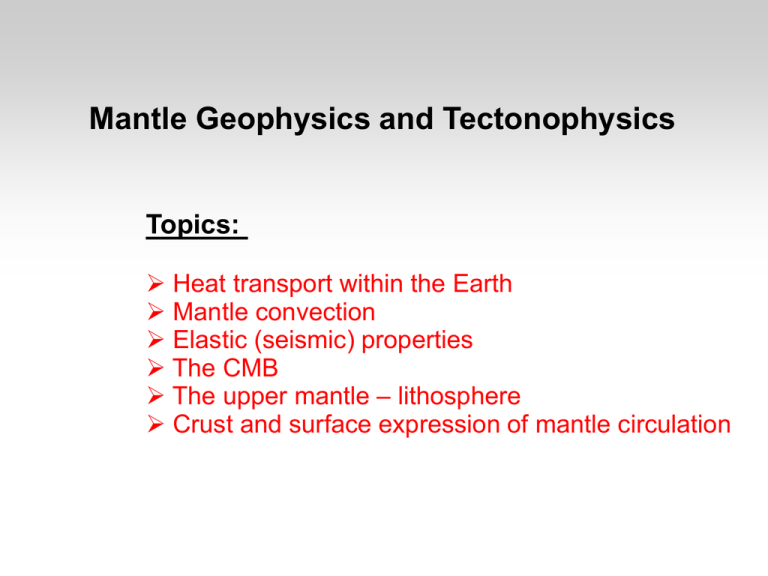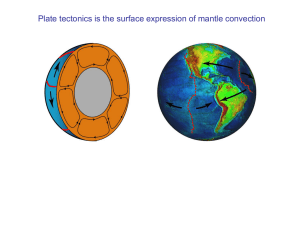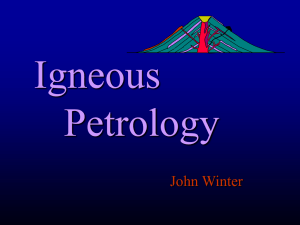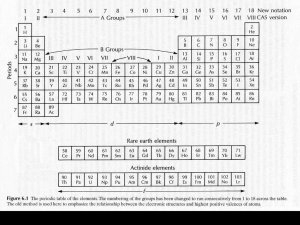Geodynamics
advertisement

Mantle Geophysics and Tectonophysics Topics: Heat transport within the Earth Mantle convection Elastic (seismic) properties The CMB The upper mantle – lithosphere Crust and surface expression of mantle circulation A simple Earth model Heat conduction through the lithosphere The Earth is cooling... losing internal energy. Heat is being released from the Earth's interior at a rate of about 44TW. Averaged over the surface of the Earth, this amounts to a heat flow of about 70mW/m2 through the crust . Heat energy diffuses through the crust and lithosphere by conduction according to Fourier's Law of Thermal Conduction. With magmas at volcanoes and spreading ridges, heat is being advected to the surface. Actually, this accounts for only a fraction of the heat that is brought to the surface and radiated through the atmosphere into space. Global distribution of heat flow Temperature through the lithosphere and crust For a lithosphere with 100km depth (i.e., an average gradient of 12K/km), the average lithospheric thermal conductivity: k ~ 4 W m-2 K-1 . Measured conductivities of surface rocks: k ~ 2-3 W m-2 K-1 . Thermal diffusion (conductive) Thermally driven mantle convection The contribution of diffusive cooling of the mantle is insignificant in comparison to convective heat transport through the mantle. The mantle behaves like a viscous fluid on long timescales; being a fluid, it can flow and can be driven into convection by a temperature gradient. Heat flows out of the depths of the cooling Earth transported through the mantle between the D'' layer and the base of the lithosphere by convective fluid motions rather than conduction. This is the more effective means of moving heat through a fluid. How does convection work? Adiabatic compression Consider a cube of mantle material under pressure Adiabatic temperature gradient Mantle temperature? If the actual temperature gradient exceeds the adiabatic gradient? If the actual temperature gradient (i.e. the increase of temperature with depth) exceeds the local adiabatic temperature gradient, then any infinitesmal displacement of a volume of mantle material will be enhanced through bouyancy if displaced upwards or negative bouyancy if displaced downwards. We have “convection”! The process of convection removes heat from depth in the mantle to the base of the lithosphere where it is conducted out to the surface. The interior cools; the actual temperature gradient reduces. The process of convection pulls the entire mantle temperature toward the adiabatic gradient. If the temperature gradient falls to the adiabatic or below, convection ceases! Temperature gradient in the mantle Vigourous convection in the mantle pulls the actual temperature gradient toward the adiabatic gradient. If the temperature at the base of the lithosphere is 1500K as corresponds to Hawaiian lava eruptions, then the adiabatic gradient to top of the D'' layer would account for a base temperature in excess of about 2100K depending on the distributed thermal expansivity, αp , and heat capacity, Cp, throughout the mantle. Heat “conducts” into the fluid mantle through the D'' boundary layer. Vigour and Rayleigh Number Convection can be driven by internal or bottom heating. Surely, both contribute. The Rayleigh number measures the ratio of the forcing-toretardation of the convection. For internal heating: For bottom heating: Here, η is the local viscosity, Tsx, the local adiabatic excess. d is mantle thickness, base of lithosphere to D''. The 660km spinel-perovskite transition adiabat The negative Clapyron slope shows an endothermic effect as the mantle rises through the 660km transition. The absorbed heat contributes a slight cooling and relative density increase that retards convection. The effect reverses for a descending lithospheric plate or slab. Layered mantle convection? There is/was a long-standing debate concerning the possibly layered convection in the mantle. There is general agreement that the 660km phase change does retard sinking subducting plates and bouyant rising melts during convection. There is also general agreement that plates can and do penetrate through 660 and that rising plumes and convective sheets rise through 660. Seismic tomography shows that we have a pooling of material around 660 as would be expected of layered convection while there remains sufficient penetration to involve the whole mantle in the convective process. from seismology.harvard.edu D'' – postperovskite transition Recently, it has been determined that the perovskite mineral phase of [Mg, Fe]SiO3 compresses into a denser postperovskite phase (same stoichiometry?) at about 120GPa pressure and 2500K temperature. This condition is interpreted to be the cause of the seismic, velocity-slowing anomaly of the D'' layer. This is not entirely out-of-line with our adiabatic temperature estimate; we don't have tight measures of thermal expansivity, αp , and heat capacity, Cp, throughout the mantle. The missing ingredient: Kie Hirose Boundary layers – lithosphere and CMB-D'' Heat conducts into the mantle from the core through the D'' boundary layer. Heat is carried through the mantle to the base of of the lithosphere via convection. Heat is conducted through the lithosphere to the crust and surface. Convection moves heat with a smaller temperature gradient than does conduction. The temperature gradients across the D'' layer and lithosphere are much greater than through the 2900km of the mantle! Heat conduction through D'' The D'' layer is between 100 and 200 km thick. It's area is about ¼ that of the Earth's surface area. The heat flow from the core into the mantle is variously estimated* to be ~9 TW. The heat flux, then, is about 40 mW m-2. If the thermal conductivity is similar to that of the lithosphere, ~4 W m-2 K-1, the temperature gradient through the D'' layer takes us to a temperature of 3500-4000 K. *See Don Anderson: Energetics of the Earth http://www.mantleplumes.org/Energetics.html The outer and inner core Temperature and pressure within Earth The outer core is convecting vigourously; its temperature gradient must be very close to adiabatic. Still, we don't have good constraints on the thermal properties of the liquid outer core. Temperature at the inner-core/outer-core boundary? Probably about 4500 K. Assuming an essentially iron-nickel inner core and adiabatic equilibrium, the inner core's central temperature is estimated to be about 5500 K. Mao and Hemley, 2007 Part II Seismotectonics Kanimori (1977) estimated that earthquakes release (use) about 5 x 1017 J per year. The theoretical limit of the annual energy available from the convective heat engine is about 5.4 x 1020 J per year. The work “done” by earthquakes accounts for only about 0.1% of the annual energy available to the convection engine. What else? Moving masses laterally across the geoid requires no work apart from the resistance or friction of the motions. Lifting masses above the geoid requires work. On long time scales, we believe that the topography of the Earth is approximately stable: uplift and erosion are in balance. The energy required to uplift the topography must somehow be provided by the convection engine. Seismotectonics The heat engine that is expressed in mantle convection works on the body and surface of the Earth. It is not an especially thermodynamically “efficient”: its theoretically limiting efficiency is determined by the temperature differences at the bottom and top of the circulating mantle. We might expect, then, that the convection engine could accomplish “work” at the rate of about 17TW. This is a tremendous power to move and uplift continents, spread ocean basins, lift mountain-building magmas above the surface and fracture surface rocks in earthquakes. Powering mantle convection The mantle engine's power derives from several possible sources: A chondritic Earth should contain enough U, Th and K to account for much of the heat flow from the surface. Fe 32.0 % O 29.7 Si 16.1 Mg 15.4 Ca, Al, Na 3.5 K 160 ppm (0.0187 40K) Th 0.055 U 0.015 McDonough, 2003 Powering mantle convection - II The mantle engine's power derives from several possible sources: A chondritic Earth should contain enough U, Th and K to account for much of the heat flow from the surface. 40K > 40Ar*, 232Th 40Ca > 208Pb 235U,238U > 207Pb,206Pb 2.79 x 10-5 W/kg 2.69 x 10-5 9.71 x 10-5 Total present-day instantaneous combined radiogenic heat source estimate for the BSE (bulk silicate Earth): Anderson, 2009 12.7 – 31TW. * It has been argued that the atmospheric mass of argon (1.29% of the atmospheric mass) entirely derives from the decay of 40K during the history of the Earth. Presently, 40K comprises 0.0117% (atom count) of natural K. 40K -> 40Ar, 40Ca Core convection and the geodynamo Compensation for the continuing dissipation of the geomagnetic field requires a continuous power input of ~0.54TW (various estimates) to maintain the field. The convective engine of the core provides this power input. Thebelieve temperature under which this engine operates is If we ourgradient temperature profile, we might (we have) estimated to range from about to 4300K. accept Andersons's 9mW/m2 heat 5100K flow from the The theoretically limiting core into the mantle ... efficiency of this engine – it is this engine that drives the geodynamo – is then: Caveat But! Note that our argument is really a circular one. ~77% of the power available in the convective engine is We have obtained our temperature on the basis ofout exhausted into the mantle. This corresponds to a heat flow Anderson's heat estimate: ~9TWand possibly more of the core into the flow mantle of at least 1.8TW than 14TW if all the available power of the convection drive feeds the geodynamo. There are myriad other losses. Powering core convection We tread on very soft ground of assumption here. Latent heat of fusion of inner core: depends upon the rate and history of freezing of the core. We may argue that the core started freezing 3.5Ga or as recently as 1Ga. Radioactive isotopes in the core and, preferentially, incorporated into the inner core. 40K is the best candidate. Chemical differentiation releasing light elements into the outer core as Fe-Ni crystallize to form the inner core. A small metallic fissile U-Th core at the centre of the inner core... probably fanciful but possibly testable. Fossil primordial heat assembled during accretion. Properly, simply the continuing cooling of the overlying mantle... sometimes seen as “entropy increase”. 0.1 - 1TW 0.1 - 1TW 0.1 - 1TW 0 - 1TW Probably enough Formation of the oceanic crust and lithosphere The ocean basin deepens with distance from the spreading ridge as a consequence of isostatic adjustment Ocean bathymetry GEBCO The ocean ridges are the shallowest regions of the basins; they are also the youngest! Mathematical-physical theory v Mathematical-physical theory - II v Mathematical-physical theory - III Mathematical-physical theory - IV Much manipulation (Sandwell; 2001 ) takes us here: To Surface temperature 0 C Tm Mantle temperature 1300 C Tl Boundary temperature 1100 C D Thermal diffusivity 8 x10-7 m2/s k Thermal conductivity 3.3 W/m/K The error function: erf(x) Explore this special function on Wolfram|Alpha What happens at a subduction trench? We have seen how the oceanic crust and upper-mantle lithosphere form and deepen as the plate spreads from a ridge. The Earth remains finite in area so that lithospheric plate has to be consumed back into the volume of the Earth somewhere... Where? Along “subduction zones”. How does subduction work? Forces acting of lithospheric plates Exploring some tectonic stories and maps http://pubs.usgs.gov/gip/dynamic/understanding.html http://earthquakescanada.nrcan.gc.ca/zones/cascadia/mega-eng.php http://earthquakescanada.nrcan.gc.ca/zones/cascadia/strain-eng.php http://denali.gsfc.nasa.gov/dtam/data/ftp/gtam.gif http://denali.gsfc.nasa.gov/dtam/data/ftp/dtam.gif http://denali.gsfc.nasa.gov/dtam/seismic/ http://www.gps.caltech.edu/~dla/images/n_polar.jpg http://www.gps.caltech.edu/~dla/images/s_polar.jpg http://www.gps.caltech.edu/~dla/images/oblique.jpg Part III Plate tectonics! Global topography Why continents? ...from Scholl Formation of continents ...from McCulloch and Bennett 206Pb/238U Accretion of the continents 207Pb/235U From Assynt's Geology Rino, et al., 2004 Uranium – lead geochronology Jack Hills Zircons Peck, et al., UWisconsin Global crustal thickness WikiMedia Commons The plate-tectonic paradigm by Vigil, USGS The plates! WikiMedia Commons







